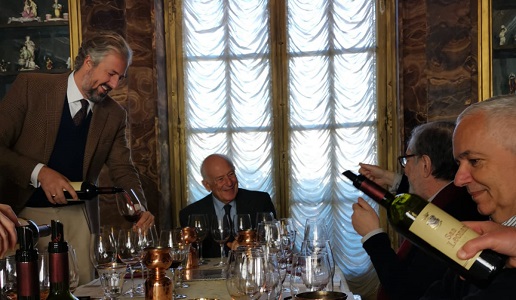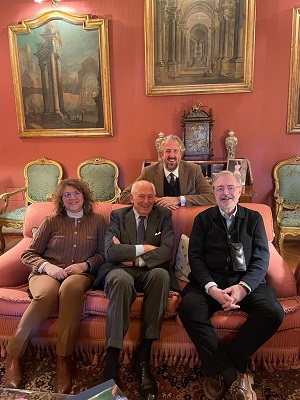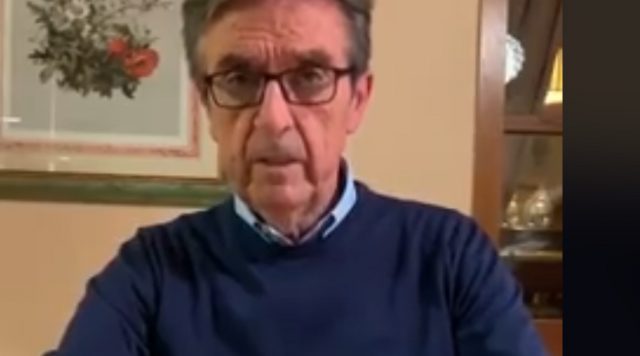Complete San Leonardo vertical tasting (1)

In the aristocratic setting of Palazzo Taverna, the Roman residence of the Marquis Guerrieri Gonzaga family, we were able to organize – in exclusive for DoctorWine – a wonderful vertical tasting of all the vintages of a great Trentino Bordeaux blend: San Leonardo.
It is rare to find a wine that is so similar to its producer, in this case San Leonardo. I realize that this statement may seem a bit of a stretch but how else can one explain the elegance, class, finesse and solemness of this magnificent wine except by looking at who produces it? The Marquis Carlo Guerrieri Gonzaga and his son Anselmo are just like their wine and even if this cannot be explained scientifically, there’s no denying it.
For those unfamiliar with this wine, San Leonardo is a Bordeaux blend that has been produced since 1982 in Trentino, more specifically in Borghetto d’Avio, an area that from the unification of Italy and until the end of the First World War marked Italy’s border with the Austro-Hungarian Empire. This places it more to the north than Bordeaux. The area of Campi Sarni, in Vallagarina, is a unique zone where the mountains overlooking its surrounding hills and the nearby Lake Garda mitigate the cold weather and ensure a microclimate that is fresh and dry.

Carlo Guerrieri Gonzaga studied winemaking and when he was young worked for his uncle Mario Incisa della Rocchetta at his Tenuta San Guido winery in Bolgheri. This was before Giacomo Tachis came onboard as enologist and created the definitive version of Sassicaia. Thus it was no surprise that the idea of a Bordeaux blend would be on his mind and among his skills. When he became involved in his family’s estate he followed this path and it was clearly evident in San Leonardo from its first vintage. The blend was from the start composed of Carmenère (mistaken for Cabernet Franc) and Merlot, which were cultivated on the estate since the 1960s, together with Cabernet Sauvignon, which was planted there in 1978. Towards the end of the 1990 some real Cabernet Franc was used and they realized the mistake they had always made in the area. Nevertheless, Carmenère remained in the blend since it has always been a characteristic of San Leonardo.
Tachis was the obvious choice as enologist for this wine and he stayed on until 2001, when he passed responsibility over to Carlo Ferrini, who basically changed little of the wine’s style. That year also saw Anselmo Guerrieri Gonzaga join the estate’s team and he went on to prove that he was as equally passionate about the land and production, and as skilled and bright as his father.
Like all great wines, San Leonardo “reflects” the year but for the most part we can say it remains an immutable wine that maintains its intrinsic characteristics and personality that is so Bordeaux and yet also Trentino at the same time. Balsamic and elegant, fresh and balanced. It is one of Italy’s greatest red wines, one which, year after year, critics all agree on and that is always ranked high on the “super-standings” found in various guides. (For the record, this year a cross-reference of Italian guides and ratings given by international critics placed it 6th among the 100 best Italian reds).
Production is quite simple: spontaneous fermentation in small cement vats for around two-three weeks with various daily pumping over and delestage. The wine then matures for around 24 months in French oak barriques that are both new and used two and three times.
Today we will review the first ten vintages produced, from 1982 to 1994 (some years the wine was not produced). The remaining vintages will be reviewed in the following installments, tomorrow and the next day. Tap on the name to read the data sheet.
- San Leonardo 1982 (Vino da tavola dei Campi Sarni)
- San Leonardo 1983 (Vino da tavola dei Campi Sarni)
- Vintage 1984 was not produced.
- San Leonardo 1985 (Vino da tavola dei Campi Sarni)
- San Leonardo 1986 (Vino da tavola dei Campi Sarni)
- San Leonardo 1987 (Vino da tavola della Vallagarina)
- San Leonardo 1988 (Vino da tavola della Vallagarina)
- Vintage 1989 was not produced.
- San Leonardo 1990 (Vino da tavola della Vallagarina)
- San Leonardo 1991 (Vino da tavola della Vallagarina)
- Vintage 1992 was not produced.
- San Leonardo 1993 (Vino da tavola della Vallagarina)
- San Leonardo 1994 (Vino da tavola della Vallagarina)

 Italiano
Italiano



















